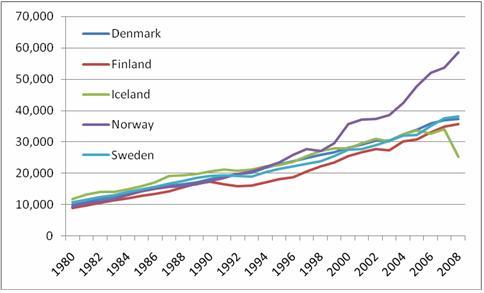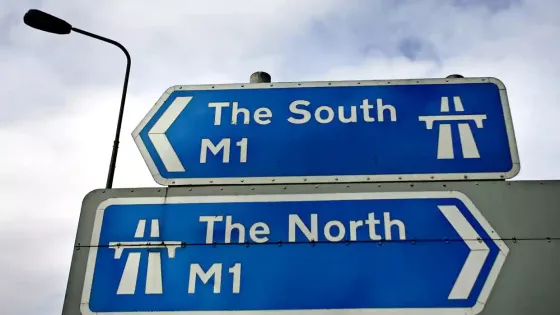Iceland’s economic crisis has destroyed wealth equivalent to about seven times its GDP. The damage inflicted on foreign creditors, investors, and depositors amounts to about five times its GDP, while the asset losses thrust upon Icelandic residents account for the rest. These figures do not include the cost of Iceland’s increased indebtedness. Iceland’s gross public debt, domestic and foreign, is estimated to increase by more than 100% of GDP as a result of the collapse of the banks, or from 29% of GDP at the end of 2007 to 136% by the end of 2010. In 2009, the government spent almost as much on interest payments as on healthcare and social insurance, the single largest public expenditure item. The damage due to Iceland’s tarnished reputation is harder to assess.
A number of economists have discussed the consequences of Iceland’s troubles and suggested solutions (Buiter and Sibert 2008, Danielsson 2010), but a key question remains: How could this happen?
To make a long story short (for the longer story, see Gylfason et al. 2010), the absence of checks and balances that had led to an unbalanced division of power between the strong executive branch and the much weaker legislative and judicial branches came to haunt the country when unscrupulous politicians put the new banks in the hands of reckless owners who then found themselves in a position to expand their balance sheets as if there were no tomorrow – and no supervision. Politicians who privatise banks by delivering them on a silver plate to their friends are not very likely to subject the banks to stringent supervision or other such inconveniences.
Collective guilt and responsibility
Iceland’s predicament raises old questions about collective guilt and responsibility. Many wonder how taxpayers can be held responsible for the failures of private bankers. But taxpayers are also voters – many of them voted for the politicians who sided with the bankers, having abstained or voted for the opposition is clearly not a valid excuse. Guilty or not, many feel responsible as taxpayers, but not all.
Opinion polls suggest that a majority of the electorate did not want parliament to approve the IceSave deal between Iceland, the UK, and the Netherlands by which Iceland agrees to repay the British and the Dutch about a half of the amount that the latter unilaterally decided to pay out in compensation to depositors in the IceSave accounts of Landsbanki.1
The stakes are high because Iceland’s agreement with the IMF appears to hinge on the parliament’s approval of the deal with the British and the Dutch. As it turned out, even this is not enough, because the President of Iceland chose to intervene by referring the IceSave law to a national referendum. It is a matter of record that the stipulation concerning the deal on the IceSave accounts is part of the IMF-supported programme at the behest of the Nordic countries, or at least some of them (Gylfason 2009). Without their support, the programme – with less financing available – would require stricter adjustment of public expenditures and taxes. In other words, without a settlement of the IceSave dispute, Iceland’s short-run crisis would deepen – an almost certain outcome of a “no” vote in the referendum scheduled for 6 March.
Parting company
In 2009, while the unemployment rate shot up to 9% of the labour force, a very high rate by Icelandic – if not by European – standards, GDP fell by 7% and is not expected to be restored to its 2008 level until 2014 in local currency at constant prices. In dollars or euros, however, per capita GDP will take longer to recover enough to regain parity with the Nordic countries because the króna is not expected to rise in value for a number of years to come. As a result of the collapse of Iceland’s banks and of the króna, Iceland’s GNI per person sank in 2008 to a level one-third below that of Denmark, Finland, and Sweden (see Figure 1; Norway’s oil puts it in a class of its own). Due to emigration, Iceland’s population fell slightly in 2009 for the first time since 1889. Significant emigration over the next few years would weaken the tax base and depress the living standards of those who stay.
Figure 1. Nordic countries: Gross National Income per capita 1980-2008 (at purchasing power parity, current international $)
Source: World Bank, World Development Indicators 2009.
And the lessons?
What can be done to reduce the likelihood of a repeat performance – in Iceland and elsewhere? Here are eleven main lessons from the Iceland story, lessons that are likely to be relevant in other, less extreme cases as well.
Lesson 1. We need effective legal protection against predatory lending just as we have long had laws against quack doctors. The problem is asymmetric information. Doctors and bankers typically know more about complicated medical procedures and complex financial instruments than their patients and clients. The asymmetry creates a need for legal protection through judicious licensing and other means against financial (as well as medical) malpractice to protect the weak against the strong.
Lesson 2. We should not allow rating agencies to be paid by the banks they have been set up to assess. The present arrangement creates an obvious and fundamental conflict of interest and needs to be revised. Likewise, banks should not be allowed to hire employees of regulatory agencies, thereby signalling that by looking the other way, remaining regulators may also expect to receive lucrative job offers from banks.
Lesson 3. We need more effective regulation of banks and other financial institutions; presently, this is work in progress in Europe and the US (Volcker 2010).
Lesson 4. We need to read the warning signals. We need to know how to count the cranes to appreciate the danger of a construction and real estate bubble (Aliber’s rule). We need to make sure that we do not allow gross foreign reserves held by the central bank to fall below the short-term foreign liabilities of the banking system (the Giudotti-Greenspan rule). We need to be on guard against the scourge of persistent overvaluation sustained by capital inflows because, sooner or later, an overvalued currency will fall. Also, income distribution matters. A rapid increase in inequality – as in Iceland 1993-2007 and in the US in the 1920s as well as more recently – should alert financial regulators to danger ahead.
Lesson 5. We should not allow commercial banks to outgrow the government and central bank’s ability to stand behind them as lender – or borrower – of last resort. In principle, this can be done through judicious regulation, including capital and reserve requirements, taxes and fees, stress tests, and restrictions on cross-ownership and other forms of collusion.
Lesson 6. Central banks should not accept rapid credit growth subject to keeping inflation low – as did the Federal Reserve under Alan Greenspan and the Central Bank of Iceland. They must take a range of actions to restrain other manifestations of latent inflation, especially asset bubbles and large deficits in the current account of the balance of payments. Put differently, they must distinguish between “good” (well-based, sustainable) growth and “bad” (asset-bubble-plus-debt-financed) growth.
Lesson 7. Commercial banks should not be authorised to operate branches abroad rather than subsidiaries if this entails the exposure of domestic deposit insurance schemes to foreign obligations. This is what happened in Iceland. Without warning, Iceland’s taxpayers suddenly found themselves held responsible for the moneys kept in the IceSave accounts of Landsbanki by 400,000 British and Dutch depositors. Had these accounts been hosted by subsidiaries of Landsbanki rather than by branches, they would have been covered by local deposit insurance in Britain and the Netherlands.
Lesson 8. We need strong firewalls separating politics from banking because politics and banking are not a good mix. The experience of Iceland’s dysfunctional state banks before the privatisation bears witness. This is why their belated privatisation was necessary. Corrupt privatisation does not condemn privatisation, it condemns corruption.
Lesson 9. When things go wrong, there is a need to hold those responsible accountable by law, or at least try to uncover the truth and thus foster reconciliation and rebuild trust. There is a case for viewing finance the same way as civil aviation: there needs to be a credible mechanism in place to secure full disclosure after every crash. If history is not correctly recorded without prevarication, it is likely to repeat itself.
Lesson 10. When banks collapse and assets are wiped out, the government has a responsibility to protect jobs and incomes, sometimes by a massive monetary or fiscal stimulus. This may require policymakers to think outside the box and put conventional ideas about monetary restraint and fiscal prudence temporarily on ice. A financial crisis typically wipes out only a small fraction of national wealth. Physical capital (typically three or four times GDP) and human capital (typically five or six times physical capital) dwarf financial capital (typically less than GDP). So, the financial capital wiped out in a crisis typically constitutes only one fifteenth or one twenty-fifth of total national wealth, or less. The economic system can withstand the removal of the top layer unless the financial ruin seriously weakens the fundamentals.
Lesson 11. Let us not throw out the baby with the bathwater. Since the collapse of communism, a mixed market economy has been the only game in town. To many, the current financial crisis has dealt a severe blow to the prestige of free markets and liberalism, with banks – and even General Motors – having to be propped up temporarily by governments, even nationalised. Even so, it remains true that banking and politics are not a good mix. But private banks clearly need proper regulation because of their ability to inflict severe damage on innocent bystanders.
Footnotes
1 According to the IceSave agreement, Iceland must during 2016-23 pay the UK 2.350 million pounds and the Netherlands about 1.330 million euros. The sum of the two figures is equivalent to about a half of Iceland’s GDP in 2009, and seems, with reasonable asset recovery, likely to overstate the ultimate cost involved. The interest rate on the loans is 5.5% per year.
References
Buiter, Willem and Anne Sibert (2008), “The Icelandic banking crisis and what to do about it”, CEPR Policy Insight 26.
Danielsson, Jon (2010), “The saga of Icesave”, CEPR Policy Insight 44.
Gylfason, Thorvaldur (2009), “Governance, Iceland, and the IMF”, VoxEU.org, 26 September.
Gylfason, Thorvaldur , Bengt Holmström, Sixten Korkman, Hans Tson Söderström, and Vesa Vihriala (2010), “Nordics in Global Crisis”, The Research Institute of the Finnish Economy (ETLA), Helsinki.
Volcker, Paul (2010), “How to Reform Our Financial System,” New York Times, 31 January.



